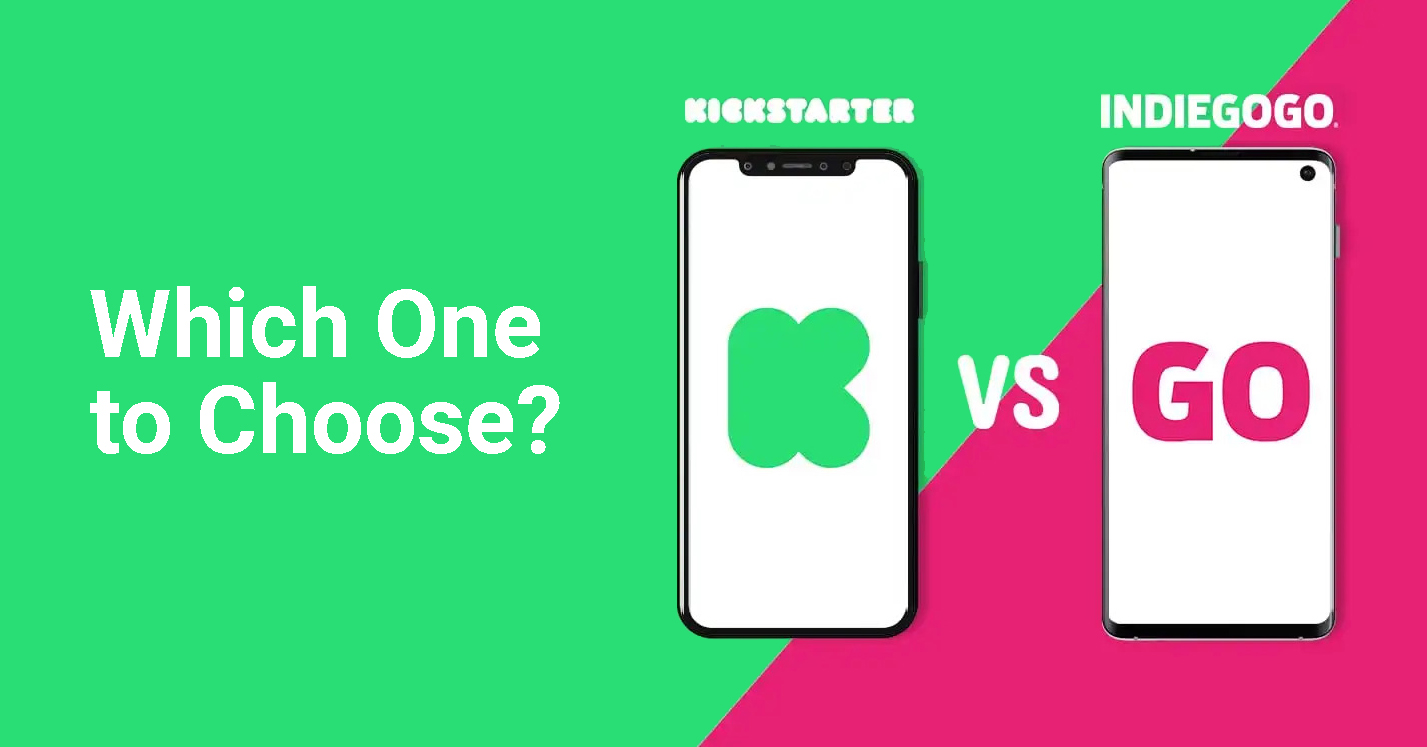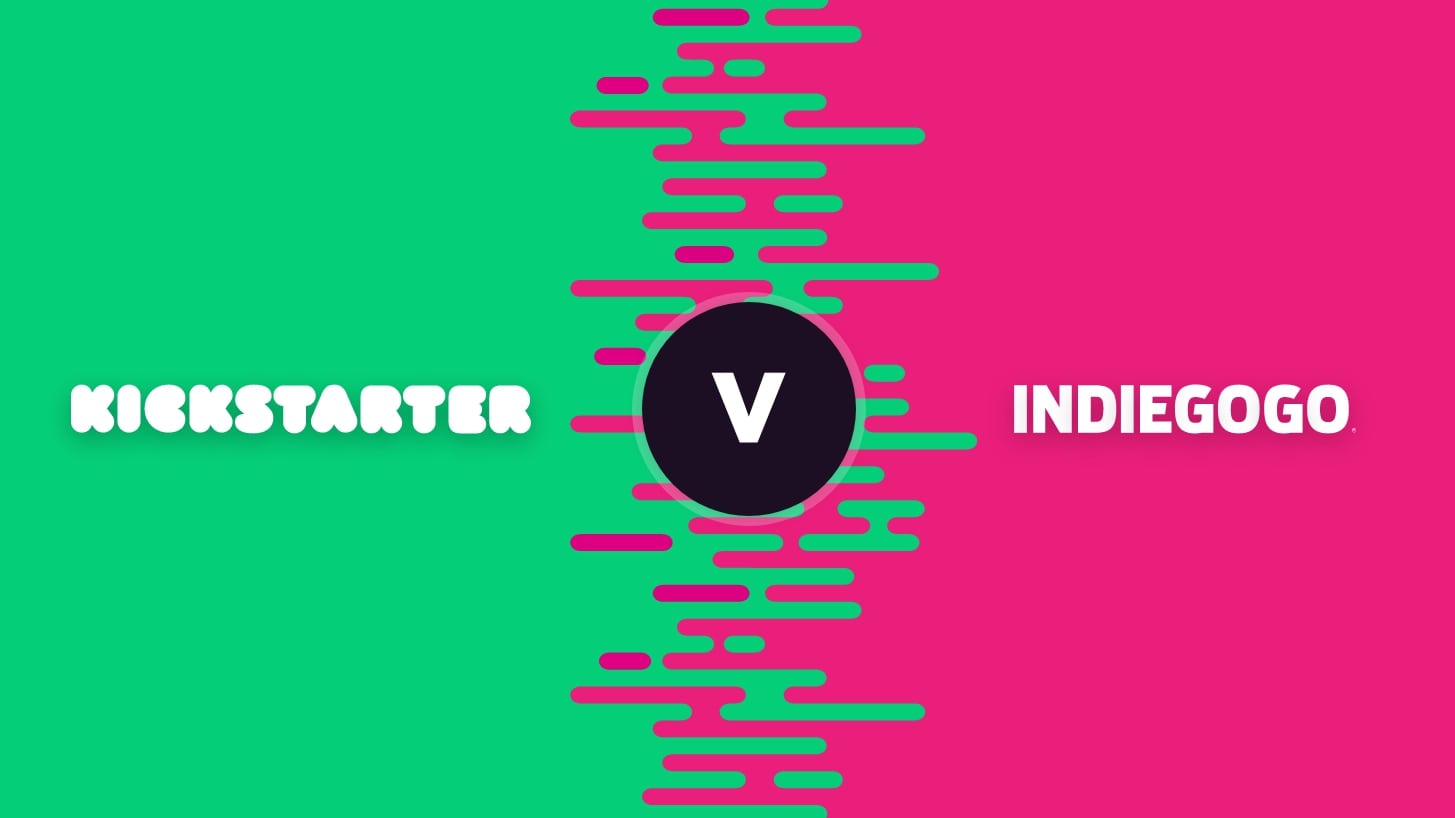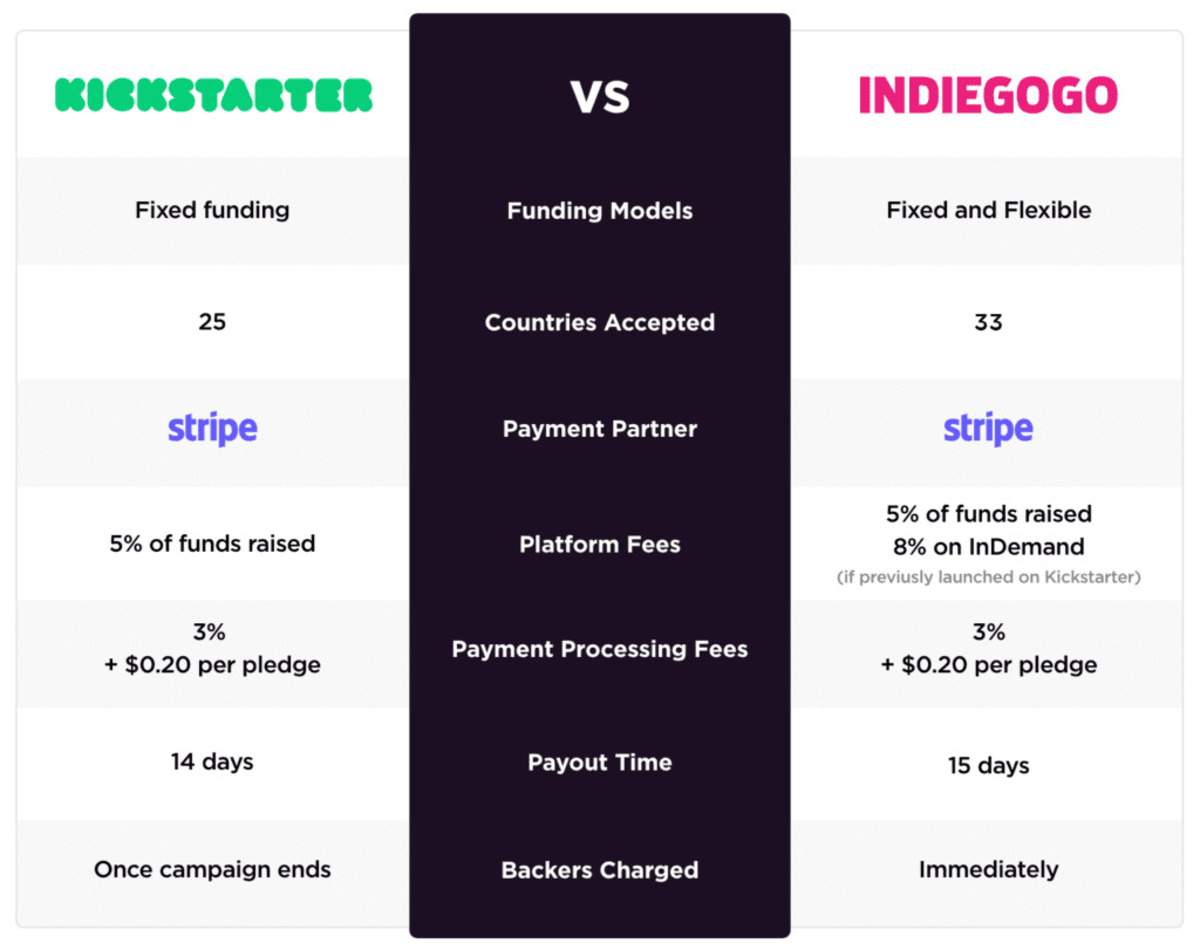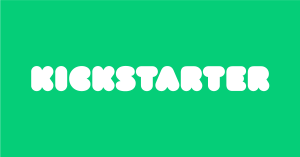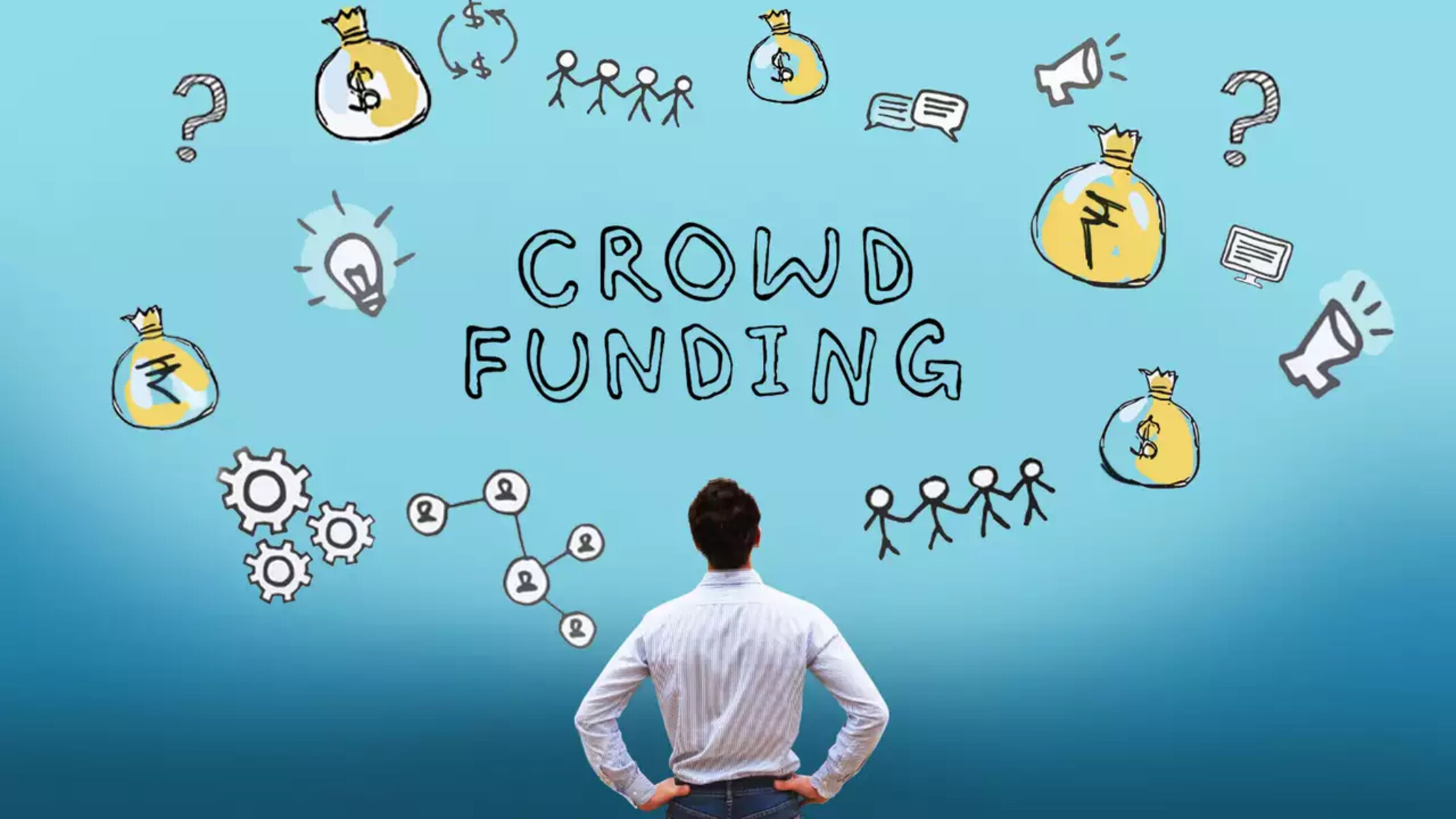Introduction
Crowdfunding has revolutionized the way entrepreneurs, creatives, and innovators bring their projects to life. It allows them to reach a wide audience and secure financial support from individuals who believe in their vision. With an extensive range of crowdfunding platforms available, it can be overwhelming to determine which one is the best fit for your project.
In this article, we will explore two popular crowdfunding platforms – Kickstarter and Indiegogo. We will compare their key features, funding models, project approval process, fees structure, geographic reach, and backer community to help you make an informed decision.
Kickstarter and Indiegogo both offer creators an online platform to showcase their projects, generate funds, and build a community. They provide a streamlined and user-friendly interface, making it easy for both project creators and backers to engage with campaigns.
Whether you have an innovative tech gadget, a creative film project, a community initiative, or a fashion line, Kickstarter and Indiegogo can potentially offer you access to a pool of global backers who are passionate about supporting groundbreaking ideas.
So, let us dive into the world of Kickstarter and Indiegogo, compare their unique features, and explore the advantages and disadvantages of each platform to help you decide which one suits your crowdfunding needs.
Overview of Crowdfunding Platform Options
When it comes to crowdfunding, there are numerous platforms available, each with its own unique features and benefits. While Kickstarter and Indiegogo stand out as two of the most popular options, it’s important to understand the landscape of what crowdfunding platforms offer before making a decision.
Kickstarter and Indiegogo are both reward-based crowdfunding platforms, meaning that backers pledge a certain amount of money in exchange for a reward or product. However, there are other crowdfunding models to consider as well, such as equity-based crowdfunding where investors receive a stake in the company, donation-based crowdfunding where funds are collected for a charitable cause, and lending-based crowdfunding where backers lend money to the project creator.
When choosing a crowdfunding platform, it’s crucial to consider factors such as project eligibility, funding goals, fees, community engagement, and geographical reach. Different platforms have varying requirements and restrictions, so thoroughly researching and understanding these aspects is essential.
While Kickstarter and Indiegogo are known for their broad appeal and diverse range of projects, there are other platforms that may be more suitable for niche industries or specific regions. For example, GoFundMe is popular for personal fundraising campaigns, Patreon focuses on supporting content creators, and SeedInvest specializes in equity crowdfunding for startups.
Furthermore, some platforms cater to specific countries or regions, making them more attractive for creators targeting local markets. For instance, Ulule is popular in Europe, Pozible is well-established in Australia, and Makuake is a leading platform in Japan.
It’s worth noting that choosing the right crowdfunding platform is not a one-size-fits-all approach. Each project has its unique needs, target audience, and fundraising goals, so it’s crucial to consider the features and advantages offered by different platforms to ensure the best fit for your specific project.
In the following sections, we will delve into the details of Kickstarter and Indiegogo, comparing their features, funding models, project approval processes, fees structure, geographic reach, and backer communities to help you make an informed decision.
What is Kickstarter?
Kickstarter is one of the pioneering crowdfunding platforms, known for its focus on creative projects and innovative ideas. It provides a platform for creators to showcase their projects and raise funds from a community of backers.
Launched in 2009, Kickstarter has become a go-to platform for a wide range of projects, including art, music, film, technology, design, and more. Its mission is to bring creative ideas to life by connecting creators with passionate supporters who believe in their vision.
One of Kickstarter’s distinguishing features is its project-based funding model. Creators set a funding goal and a specified campaign duration, during which they encourage backers to pledge their support. If the funding goal is not reached within the campaign period, the project does not receive any funds, and backers are not charged.
In addition to the all-or-nothing funding model, Kickstarter also allows creators to offer different pledge tiers. Backers can choose from various reward options based on the amount they pledge. These rewards can range from early access to the product, exclusive merchandise, personalized experiences, or even a role in the project’s development process.
Kickstarter also emphasizes community engagement, encouraging creators to share their progress, updates, and behind-the-scenes content with their backers. This open communication fosters a sense of involvement and transparency, allowing backers to feel connected to the projects they support.
Furthermore, Kickstarter’s global reach and popularity attract a diverse community of backers. The platform has helped launch successful projects worldwide, leading to collaborations, partnerships, and increased exposure for creators.
Overall, Kickstarter offers a platform where creators can showcase their innovative ideas, receive support from a passionate community, and bring their projects to life. With its project-based funding model, interactive features, and global reach, Kickstarter has solidified its position as one of the leading crowdfunding platforms in the world.
What is Indiegogo?
Indiegogo, founded in 2008, is another well-known crowdfunding platform that enables individuals and organizations to raise funds for a wide range of projects. Unlike Kickstarter, Indiegogo supports both creative projects and other types of ventures such as personal causes, entrepreneurial endeavors, and non-profit initiatives.
Indiegogo prides itself on its flexible funding model, which gives project creators more options for fundraising. Unlike the all-or-nothing approach of Kickstarter, Indiegogo allows creators to receive the funds they raise, even if they do not reach their initial funding goal.
This flexible funding model can be advantageous for projects that may not have a large following or a well-established network of backers. It allows creators to access and utilize the funds they raise, regardless of whether they reach their target, providing more opportunities for progress and success.
In addition to the flexible funding option, Indiegogo also offers creators the ability to choose from different campaign types, including fixed funding, flexible funding, and InDemand campaigns. These options provide flexibility and cater to the specific needs and goals of each project.
Indiegogo has also built a reputation as a platform that fosters innovation, featuring disruptive technologies, social justice campaigns, and products with a purpose. It has been successful in raising funds for projects in areas such as tech gadgets, sustainable products, creative arts, and social causes.
An important aspect of Indiegogo is its commitment to global reach. The platform is available in multiple languages, making it accessible to creators around the world. This global presence enables project creators to tap into a diverse network of backers, potentially increasing exposure and funding opportunities.
Moreover, Indiegogo has nurtured a strong and supportive community of backers and contributors. The platform encourages open communication between creators and backers, facilitating engagement and building a sense of community around each project. This interaction can lead to valuable feedback, collaboration, and ongoing support beyond the initial campaign.
In summary, Indiegogo offers a flexible and inclusive crowdfunding platform that supports a variety of projects, including creative ventures, personal causes, and entrepreneurial endeavors. With its flexible funding model, campaign options, global reach, and community engagement, Indiegogo has established itself as an attractive choice for creators seeking alternative crowdfunding options.
Key Differences between Kickstarter and Indiegogo
While both Kickstarter and Indiegogo are popular crowdfunding platforms, there are some key differences between the two that creators should consider when deciding which platform to use.
- Funding Models: One of the primary distinctions between Kickstarter and Indiegogo is their funding models. Kickstarter operates on an all-or-nothing model, where projects must reach their funding goal within a specified timeframe to receive any funds. Indiegogo, on the other hand, offers a flexible funding option, allowing creators to receive funds even if they don’t reach their goal.
- Project Approval Process: Kickstarter has a strict project approval process, with a team reviewing each project application to ensure they meet the platform’s guidelines. In contrast, Indiegogo has a more open approach, allowing creators to launch campaigns immediately without going through a rigorous approval process.
- Fees Structure: The fees structure of Kickstarter and Indiegogo also differs. Kickstarter charges a 5% fee on successfully funded projects, while Indiegogo charges a 5% fee for non-profit projects and campaigns that choose the flexible funding option. For fixed funding campaigns on Indiegogo, the fee is 4%.
- Geographic Reach: Both Kickstarter and Indiegogo have a global presence, but Kickstarter has a larger international reach, with projects from various countries garnering significant attention. Indiegogo, on the other hand, focuses on expanding its presence in different regions and has localized options for specific countries.
- Backer Community: While both platforms have active communities of backers, there is a slight difference in the demographics and preferences of the backers. Kickstarter tends to attract a larger number of backers interested in supporting creative projects, art, design, and innovative ideas. Indiegogo, on the other hand, has a diverse range of backers who support a wider variety of projects, including personal causes and entrepreneurial ventures.
Understanding these key differences can help project creators make an informed decision about which platform aligns best with their project goals, funding needs, and target audience. It’s essential to consider factors such as project eligibility, funding models, fees structure, geographic reach, and the preferences of the backer community when choosing between Kickstarter and Indiegogo.
Funding Models
The funding models employed by Kickstarter and Indiegogo are distinct, offering creators different options when it comes to raising funds for their projects.
- Kickstarter: Kickstarter operates on an all-or-nothing funding model. This means that project creators must set a specific funding goal and a predetermined campaign duration. Backers pledge their support, and if the funding goal is not met within the set timeframe, no funds are exchanged, and the project does not receive any money. However, if the project successfully reaches or surpasses its funding goal, the pledged funds are collected, and the project can move forward.
- Indiegogo: Indiegogo offers a more flexible funding model. Creators have the option to choose between two funding types: fixed funding and flexible funding. With fixed funding, creators must set a funding goal, similar to Kickstarter. However, backers are only charged and funds are collected if the project reaches its goal. If the project falls short of its target, no funds are exchanged. On the other hand, the flexible funding option allows creators to receive the funds they raise, regardless of whether they reach their initial goal. While this flexibility can be advantageous, it’s important for creators to keep in mind that they will be charged a higher fee if they choose the flexible funding option.
Both funding models have their own benefits and considerations. Kickstarter’s all-or-nothing model creates a sense of urgency for backers to rally around a project and reach its goal. This approach can drive momentum and ensure that projects with a clear plan for execution receive the necessary funding. On the other hand, Indiegogo’s flexible funding offers more leniency, allowing creators to access the funds they raise, even if they fall short of their initial target. This can be particularly useful for projects that may not have a large following or a well-established network of backers.
Ultimately, the choice between Kickstarter and Indiegogo’s funding models depends on the specific needs and preferences of the project. Creators should consider their funding goals, level of confidence in reaching those goals, and the potential impact of funding success or failure on their project’s timeline and development. It’s important to thoroughly evaluate these factors to select the most suitable funding model that aligns with the project’s vision and requirements.
Project Approval Process
The project approval process is an important consideration for creators when choosing between Kickstarter and Indiegogo. Both platforms have different approaches to project approval, which can impact the ease and speed at which creators can launch their campaigns.
Kickstarter: Kickstarter has a strict project approval process to ensure that campaigns meet their guidelines and standards. Creators are required to submit their project for review, where a team at Kickstarter assesses its viability and adherence to the platform’s rules. This review includes a thorough examination of the project’s goals, rewards, and overall presentation. If approved, the project creator can proceed to launch their campaign and start collecting pledges.
This careful curation process ensures that only high-quality and well-planned projects are featured on the platform. While it may add some initial wait time before launching a campaign, it also helps to maintain a level of quality and trust for backers.
Indiegogo: In contrast, Indiegogo has a more open approach to project approval. Creators can launch their campaigns immediately without going through a stringent review process. This allows for greater flexibility and autonomy in starting fundraising efforts, as creators don’t have to wait for approval before beginning their campaigns.
While Indiegogo’s approach allows for quicker campaign launches, it also means more responsibility falls on project creators to ensure that their campaigns are well-prepared and adhere to the platform’s guidelines. Indiegogo has policies in place to address fraudulent or misleading campaigns, but the initial screening process is lighter compared to Kickstarter.
It is worth noting that Kickstarter’s project approval process can result in a higher level of trust and credibility associated with their platform. This can attract more cautious backers who appreciate the added assurance that projects have undergone a thorough evaluation process. On the other hand, Indiegogo’s more open approach may appeal to creators who want the freedom to launch campaigns without delay or restrictions.
Considering the project approval processes of Kickstarter and Indiegogo is essential for project creators. It is crucial to weigh the benefits of Kickstarter’s comprehensive review process against the flexibility and speed offered by Indiegogo. Understanding the different approval procedures can help creators choose the platform that aligns best with their needs and the nature of their projects.
Fees Structure
The fees structure is an important aspect to consider when evaluating the financial implications of crowdfunding on platforms like Kickstarter and Indiegogo. Both platforms have different fee structures that creators should take into account when planning their campaigns.
Kickstarter: Kickstarter charges a 5% fee on successfully funded projects. This fee is deducted from the total funds raised, meaning that creators receive 95% of the pledged amount after the deduction. It’s important to note that Kickstarter also uses third-party payment processors like Stripe, which charge an additional processing fee of approximately 3% + $0.30 per transaction. These fees should be factored into the overall cost calculations for running a campaign on Kickstarter.
In addition to the base percentage fee, Kickstarter offers reduced fees of 3-4% for projects that fall under certain categories, such as design and technology, arts, film, and music. This fee reduction encourages projects in these categories and offers potential cost savings for creators.
Indiegogo: Indiegogo’s fee structure is slightly different from Kickstarter. For non-profit and personal cause campaigns that choose the flexible funding option, the platform charges a 5% fee. However, for fixed funding campaigns, the fee is 4%. Additionally, Indiegogo also utilizes third-party payment processors, which have their own transaction fees similar to Kickstarter’s processing fees.
Indiegogo also offers an additional program called InDemand, which allows creators to continue raising funds even after their original campaign has ended. InDemand campaigns are subject to a 5% fee, similar to their flexible funding structure. This program provides creators with the opportunity to extend their fundraising efforts and maintain a presence on the platform.
When considering fees, it’s also important to factor in any additional costs associated with fulfillment, production, shipping, and other campaign-related expenses. Crowdfunding campaigns can incur various expenses beyond platform fees, so creators should carefully consider their budget and overall financial plan when calculating the costs and potential profits of their campaign.
Understanding the fees structure of Kickstarter and Indiegogo is crucial for project creators. By considering the platform fees, transaction fees, and any applicable fee reductions, creators can make informed decisions about the financial implications and feasibility of running a campaign on each platform.
Geographic Reach
The geographic reach of a crowdfunding platform plays a significant role in determining the potential exposure and support that a project can receive. Both Kickstarter and Indiegogo have established a global presence, but there are some differences in their reach and popularity in different regions.
Kickstarter: Kickstarter has a wide international reach and is known for attracting a diverse range of creators and backers from around the world. It supports projects from dozens of countries, including the United States, Canada, the United Kingdom, Australia, and many others. This global presence allows creators to tap into a diverse pool of potential backers who are actively looking to support creative and innovative projects.
With its large community and global recognition, Kickstarter offers projects a higher chance of gaining visibility and reaching a broad audience. However, it’s essential to note that Kickstarter’s popularity varies across countries, and certain regions may have a more active backer community than others.
Indiegogo: Indiegogo also boasts a global reach, with the platform making efforts to expand its presence in different regions. While Indiegogo is available worldwide and supports projects from various countries, it has placed additional emphasis on localizing its platform to cater to specific countries, such as the United States, Canada, the United Kingdom, Germany, and France.
This localized approach by Indiegogo aims to provide tailored support and services to creators and backers in specific regions, fostering a sense of community and engagement. By focusing on localization, Indiegogo aims to attract more campaigns and enhance the crowdfunding experience for creators and backers alike.
It’s important for project creators to consider the geographic reach of a crowdfunding platform based on their target audience and project goals. While Kickstarter generally offers a broader international reach, Indiegogo’s localized efforts may be more appealing for projects targeting specific countries or regions.
Moreover, factors such as language options, currency support, and customer support in different regions can also impact the overall experience for creators and backers. Evaluating these factors can help project creators determine which platform aligns best with their target audience and geographic considerations.
Backer Community
The backer community is a critical aspect of crowdfunding platforms, as it represents the individuals who pledge their support and contribute to the success of projects. Understanding the characteristics and preferences of the backer community can help project creators select the ideal platform for their specific project.
Kickstarter: Kickstarter has a robust and engaged backer community. It attracts backers who are passionate about supporting creative and innovative projects across various industries such as art, design, film, music, technology, and more. Kickstarter’s community is known for its openness to new ideas and willingness to take risks on projects that push boundaries.
The Kickstarter community tends to consist of early adopters, creative enthusiasts, and individuals who enjoy being part of the project’s journey. As a creator, this offers the opportunity to connect with like-minded individuals who actively support and promote projects they are passionate about.
Creators also benefit from Kickstarter’s reputation as a platform for high-quality and well-executed projects. This reputation can attract backers seeking credibility and assurance that their pledge is contributing to a project with a strong chance of success.
Indiegogo: Indiegogo’s backer community is diverse and supports a wide range of projects beyond the creative and artistic spheres. While it shares some similarities with Kickstarter’s community, Indiegogo attracts a broader audience interested in personal causes, entrepreneurship, social justice, and other areas outside the traditional creative industries.
Indiegogo’s backer community tends to be more open to different types of projects and may be driven by personal connections and individual passions. Campaigns on Indiegogo can tap into backers who are not solely focused on creative outcomes but support a wide variety of impactful ventures.
Furthermore, Indiegogo encourages direct communication between creators and backers, fostering a sense of community and engagement. This allows project creators to build relationships, gather feedback, and create a loyal following of supporters.
When deciding between Kickstarter and Indiegogo, creators should consider the characteristics and preferences of the backer community that align with their project. Understanding the community dynamics and engagement levels can help creators identify the platform that offers the best fit and potential for success.
Expert Opinion and Success Stories
When considering which crowdfunding platform to use, it can be helpful to consult expert opinions and consider success stories from past campaigns on Kickstarter and Indiegogo. These insights can provide valuable guidance and inspiration for project creators.
According to experts in the crowdfunding industry, Kickstarter is often regarded as the go-to platform for creative projects, particularly in areas such as art, design, film, and technology. The platform has a strong reputation for supporting innovative ideas and has helped launch numerous successful campaigns that have gained widespread recognition and acclaim.
Experts often praise Kickstarter’s stringent project approval process, which ensures a certain level of quality and credibility for projects featured on the platform. This level of curation and selectivity can translate into increased trust and attention from backers who have confidence in the projects showcased on Kickstarter.
Indiegogo, on the other hand, is celebrated for its flexibility, broader range of project categories, and its ability to support personal causes, entrepreneurial ventures, and social impact campaigns. The platform successfully caters to a diverse set of projects, opening up possibilities for creators in various niches to find success.
Success stories from both Kickstarter and Indiegogo further demonstrate the platforms’ effectiveness in helping creators achieve their funding goals and realize their visions. High-profile projects such as the Pebble smartwatch and the Oculus Rift virtual reality headset found success on Kickstarter, raising millions of dollars and later becoming industry-leading products.
Indiegogo has its own set of success stories, including the Flow Hive honey harvesting system and the Lomography Lomo’Instant camera. These campaigns captured the attention and support of backers globally, leading to significant funding and market recognition.
While success stories can certainly be inspiring, it’s important for creators to also consider factors such as campaign strategy, marketing efforts, and the unique appeal of each project. Each campaign is distinct and requires careful planning and execution to achieve success, regardless of the platform.
It’s beneficial for project creators to research and analyze successful campaigns within their specific project category or industry. By understanding what worked well for others, creators can learn from their experiences and apply effective strategies to their own campaigns.
Overall, expert opinions and success stories provide valuable insights and inspiration for project creators considering Kickstarter and Indiegogo. While each platform has its strengths and benefits, there is no one-size-fits-all approach, and careful planning and execution are essential for achieving crowdfunding success.
Advantages and Disadvantages of Kickstarter
Kickstarter offers several advantages to project creators, but it also comes with its own set of disadvantages that should be considered when deciding to launch a campaign. Understanding these pros and cons can help creators make an informed decision about whether Kickstarter is the right platform for their project.
Advantages:
- Strong Backer Community: Kickstarter has a large and engaged backer community that actively supports creative and innovative projects.
- High Visibility: Kickstarter is widely recognized as one of the top crowdfunding platforms, providing projects with the potential for significant visibility and exposure.
- Quality Curation: Kickstarter’s rigorous project approval process ensures a certain level of quality and credibility for projects featured on the platform.
- Focus on Creative Projects: Kickstarter’s reputation as a platform for creative endeavors attracts backers who are specifically interested in supporting artistic and innovative projects.
- Pledge Tiers and Rewards: Kickstarter allows creators to offer a variety of pledge tiers and rewards, enticing backers with unique and enticing incentives.
Disadvantages:
- All-or-Nothing Model: Kickstarter’s all-or-nothing funding model means that if the funding goal is not met within the set campaign timeframe, no funds are received, and the project does not proceed.
- Strict Project Approval Process: Kickstarter’s project approval process can be rigorous, requiring creators to meet specific guidelines and potentially resulting in delays in launching a campaign.
- Higher Platform Fee: Kickstarter charges a 5% fee on successfully funded projects, which, combined with third-party payment processing fees, can impact the overall funds received by the creator.
- Competition and Saturation: Due to its popularity, Kickstarter has a high volume of campaigns, making it more competitive for creators to gain attention and stand out among other projects.
- Focus on Creative Projects: While being a benefit, Kickstarter’s emphasis on creative projects may make it less suitable for projects outside of the arts, design, and innovation sectors.
It’s essential for project creators to weigh the advantages and disadvantages of Kickstarter, considering their project’s specific needs, funding goals, and target audience. Kickstarter’s strong backer community, high visibility, quality curation, and reward options make it an attractive platform for creative projects. However, the all-or-nothing model, the rigorous approval process, and the competitive landscape should also be taken into consideration.
Advantages and Disadvantages of Indiegogo
Indiegogo offers a range of advantages and disadvantages that project creators should consider when evaluating whether it is the right platform for their crowdfunding campaign. By understanding these pros and cons, creators can make an informed decision about utilizing Indiegogo for their project.
Advantages:
- Flexible Funding: Indiegogo’s flexible funding model allows creators to receive the funds they raise even if they do not reach their initial funding goal. This flexibility can be particularly advantageous for projects that may not have a large following or network of backers.
- Broader Project Categories: Indiegogo supports a wide range of project categories beyond creative ventures, making it suitable for personal causes, entrepreneurial endeavors, and social impact campaigns.
- Localized Support: Indiegogo has made efforts to localize its platform, providing tailored support for creators and backers in specific countries or regions.
- Active Backer Community: Indiegogo has a diverse and engaged backer community, supporting various types of projects and personal causes.
- InDemand Program: Indiegogo’s InDemand program allows creators to continue raising funds even after their initial campaign has ended, enabling ongoing support and extended fundraising opportunities.
Disadvantages:
- Less Stringent Approval Process: Indiegogo’s project approval process is less strict compared to other platforms like Kickstarter, which means that projects might not receive the same level of quality curation or credibility.
- Higher Platform Fee for Flexible Funding: While flexible funding allows creators to access funds even if they don’t reach their goal, Indiegogo charges a higher fee of 5% for non-profit campaigns and flexible funding campaigns.
- Competition and Saturation: Indiegogo, similar to other popular platforms, has a high volume of campaigns, making it competitive for creators to stand out and gain attention among other projects.
- Perception outside Creative Industries: While Indiegogo supports various project categories, it may not have the same reputation and association with creative projects compared to platforms like Kickstarter.
- Limited Localization Options: While Indiegogo has made efforts to localize its platform, its localized support might not be as extensive as some creators would prefer, particularly in specific countries or regions.
It’s crucial for project creators to carefully consider the advantages and disadvantages of Indiegogo based on their specific project requirements, funding goals, and target audience. The flexible funding model, diverse project categories, active backer community, localized support, and InDemand program make Indiegogo an attractive platform. However, creators should also take into account the less stringent approval process, higher fees for flexible funding, competition, and the platform’s positioning outside of creative industries.
Conclusion
Choosing between Kickstarter and Indiegogo for your crowdfunding campaign requires careful consideration of various factors. Both platforms offer unique advantages and disadvantages that can significantly impact the success of your project. By evaluating key aspects such as funding models, project approval processes, fees structures, geographic reach, and backer communities, you can make an informed decision based on your project’s specific needs and goals.
Kickstarter is well-known for its focus on creative projects, its strong backer community, and its high visibility. The all-or-nothing funding model and the rigorous project approval process provide assurance and credibility, but they may also add additional challenges for creators. Kickstarter’s platform fee and the competitive landscape should also be taken into account.
Indiegogo, on the other hand, has a more flexible funding model, broader project categories, and an engaged backer community that supports various causes. Its localized support and the InDemand program offer added benefits for creators. However, the less stringent approval process and higher fee for flexible funding should be considered, along with the platform’s positioning outside of the creative industries.
Ultimately, the choice between Kickstarter and Indiegogo depends on your project’s nature, target audience, funding goals, and personal preferences. It’s recommended to thoroughly research both platforms, review successful campaigns within your project category, and assess the alignment of the platform’s features with your specific project requirements. Furthermore, consider seeking advice from experts or speaking with other creators who have utilized these platforms to gain insights and perspectives.
Remember, regardless of the platform you choose, running a successful crowdfunding campaign requires careful planning, effective marketing, and ongoing engagement with your backers. With the right strategy, a compelling project, and a solid understanding of your target audience, you can increase your chances of achieving your funding goals and making your creative vision a reality.







